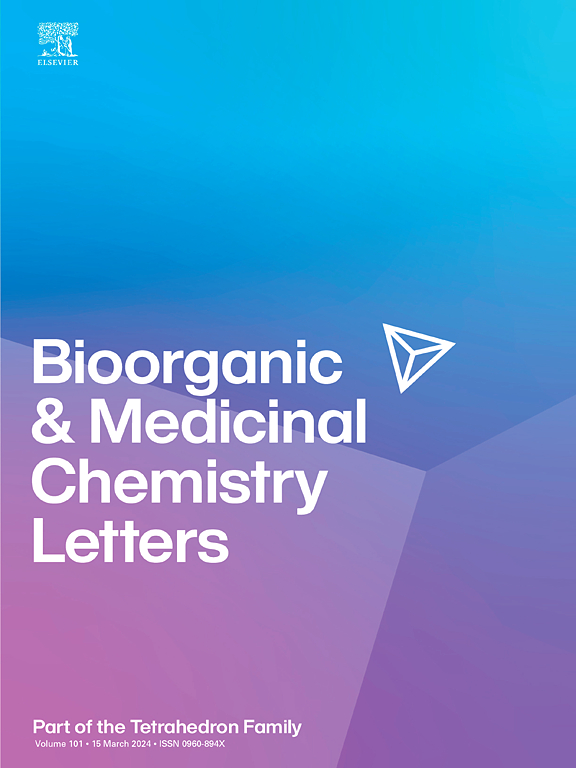Discovery of liver-selective glucokinase activators comprising N-(4-alkylthiazol-2-yl)benzamides and N-(3-alkyl-1,2,4-thiadiazol-5-yl)benzamides for the treatment of metabolic disorders
IF 2.5
4区 医学
Q3 CHEMISTRY, MEDICINAL
引用次数: 0
Abstract
Glucokinase (“GK”) plays a critical role in regulating glucose homeostasis within the body. Proof-of-concept animal models demonstrated that small molecule GK activation enhances glucose uptake and utilization by various tissues, including liver and pancreas. Accordingly, glucokinase activators (“GKAs”) were extensively explored as a potential therapy for carbohydrate metabolism disorders. Yet in clinical trials, mechanism-based hypoglycemia was often observed when GK was activated in both liver and pancreas. One ameliorative approach was to pursue hepatocentric GKAs. Described herein is a series of liver selective GKAs based on N-(4-alkylthiazol-2-yl)benzamide and N-(3-alkyl-1,2,4-thiadiazol-5-yl)benzamide pharmacophores. Optimization efforts revealed that enhanced liver selectivity could be achieved by replacing diethylphosphonate group (compound 1) with a dimethylphosphinate (compound 3). Due to mutagenicity of a putative aminoheterocycle metabolite of 3, subsequent amines were triaged using SOS chromotest. Efforts ultimately led to identification of thiazole-based compounds 11–13, which exhibited significant glucose lowering in acute DIO (“diet-induced obese”) mouse OGTT (“oral glucose tolerance test”) studies. However, insulin secretion was observed at higher doses, and thus the desired therapeutic window between efficacy and insulin secretion was not achieved. Thiadiazole-based compounds were then explored to assess whether this modification could obviate the insulin secretion observed with the thiazole series. Several thiadiazoles were discovered with exceptionally high liver selectivity and drug liver concentrations when evaluated in mouse pharmacokinetic studies. Compounds 17–19 and 20–22 were advanced into acute DIO OGTT studies, but were inactive. Notably, a relatively higher degree of plasma protein binding was observed for the non-efficacious vs. efficacious compounds.

发现含有N-(4-烷基噻唑-2-基)苯酰胺和N-(3-烷基-1,2,4-噻二唑-5-基)苯酰胺的肝选择性葡萄糖激酶活化剂,用于治疗代谢紊乱。
葡萄糖激酶(“GK”)在调节体内葡萄糖稳态中起着关键作用。概念验证动物模型表明,小分子GK激活可增强多种组织(包括肝脏和胰腺)对葡萄糖的摄取和利用。因此,葡萄糖激酶激活剂(“GKAs”)作为碳水化合物代谢紊乱的潜在治疗方法被广泛探索。然而,在临床试验中,当GK在肝脏和胰腺被激活时,经常观察到基于机制的低血糖。一种改良方法是追求以肝为中心的gka。本文描述了一系列基于N-(4-烷基噻唑-2-基)苯酰胺和N-(3-烷基-1,2,4-噻二唑-5-基)苯酰胺药物载体的肝脏选择性gka。优化工作表明,用二甲基膦酸盐(化合物3)取代二乙基膦酸盐(化合物1)可以提高肝脏选择性。由于3的一个假定的胺杂环代谢物具有突变性,随后的胺使用SOS显色法进行分类。这些努力最终鉴定出噻唑类化合物11-13,它们在急性饮食性肥胖小鼠OGTT(口服葡萄糖耐量试验)研究中表现出显著的血糖降低作用。然而,在较高剂量下观察到胰岛素分泌,因此没有达到预期的疗效与胰岛素分泌之间的治疗窗口。然后探索以噻二唑为基础的化合物,以评估这种修饰是否可以消除用噻唑系列观察到的胰岛素分泌。在小鼠药代动力学研究中,几种噻二唑被发现具有异常高的肝脏选择性和药物肝脏浓度。化合物17-19和20-22进入急性DIO OGTT研究,但无活性。值得注意的是,无效和有效化合物的血浆蛋白结合程度相对较高。
本文章由计算机程序翻译,如有差异,请以英文原文为准。
求助全文
约1分钟内获得全文
求助全文
来源期刊
CiteScore
5.70
自引率
3.70%
发文量
463
审稿时长
27 days
期刊介绍:
Bioorganic & Medicinal Chemistry Letters presents preliminary experimental or theoretical research results of outstanding significance and timeliness on all aspects of science at the interface of chemistry and biology and on major advances in drug design and development. The journal publishes articles in the form of communications reporting experimental or theoretical results of special interest, and strives to provide maximum dissemination to a large, international audience.

 求助内容:
求助内容: 应助结果提醒方式:
应助结果提醒方式:


